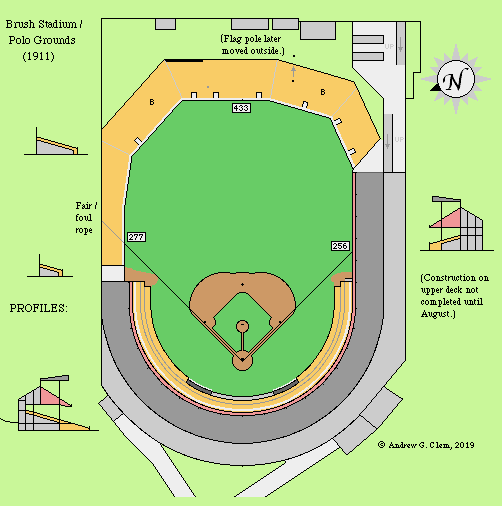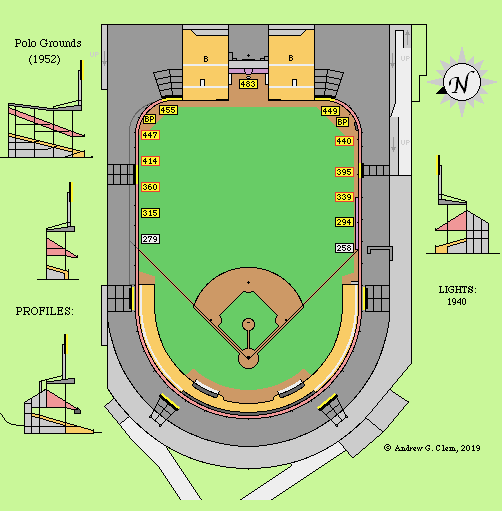The Absurdity That Was The Polo Grounds
On Friday we released the latest 'A Brief History' podcast. The Subway Series, Part I is about the great New York City baseball rivalries between the Yankees, Giants, Dodgers and Mets over the past 100+ years.
When we posted the picture below, most people commented on the absurdity that was the Polo Grounds dimensions.

Fun fact: When both stood, you could walk between Yankee Stadium and the Polo Grounds in under 20 minutes.
The Polo Grounds
The Polo Grounds (version 2) opened in 1890 at 155th and 8th Avenue (now Frederick Douglass Blvd). Version 1 was located in Central Park and originally used for -- wait for it -- polo. When the city wanted to expand its grid system, the site was demolished and moved to upper Manhattan.
Back then baseball fields were built to the specs of the lot. It didn't matter much that right field was 256-feet during the "dead ball era," but as things like equipment evolved, owners had to make do with what they had. They also had to constantly renovate the stands to keep up with the demand of the sport -- by the 1920s, the Polo Grounds had an upper and lower deck that wrapped around the entire field.
The below images are taken from Clem's Baseball Blog, where you can find iterations of numerous baseball stadiums old and new. If you're a baseball nerd looking to kill a few hours, check it out.
The Polo Grounds 1911 dimensions:

As ridiculous as the original dimensions were, it at least resembles a normal baseball outfield. But by the '20s the field evolved into something more fitting of football or auto racing (both of which took place at the Polo Grounds).
The Polo Grounds 1952 dimensions:

Among the quirky features of the Polo Grounds were that the bullpens were in play in right- and left-center field, and the cut-out square in centerfield extended the field of play unnecessarily.
By the time Babe Ruth played there, the dimensions (give or take a couple feet) were:
Left Field: 279 ft Left-Center: 450 ft Center Field: 483 ft Right-Center: 449 ft Right Field: 258 ft
No wonder his home run total jumped from 29 in 1919 with the Red Sox to 54 in 1920 with the Yankees. (It is also important to note that Ruth's 29 HRs in 1919 led the league).
Because Ruth and others got used to hitting corners (Who the hell wants to hit to a 483-foot centerfield?) the Yankees built a stadium with specs The Babe would approve of.
Yankee Stadium 1923 dimensions:

The discussion of how the Polo Grounds affected stars like Ruth and how stars of today would perform naturally comes up. This blurb from The Hardball Times sums it up:
https://twitter.com/Andrew_Rotondi/status/1259236530511585283?s=20
Two Teams, One Ballpark
After the Yankees (then called the Highlanders) left Hilltop Park following the 1912 season, they shared the Polo Grounds with the Giants.
The two teams played on the same field until Giants owner Charles Stoneham evicted the Yankees in 1920, forcing them to open a field of their own. "Yankee Ballpark," as it was originally named, was set to open in 1923, so the Yankees were allowed to play at the Polo Grounds until then. Thankfully the name was changed to "Yankee Stadium" prior to opening ("Stadium" just has more punch than "Ballpark").
It was no mystery why Stoneham grew tired of the Yankees. For years, the Giants were the biggest draw in town but in 1920 the Yankees out-drew the Giants in attendance 1.3-million to 930-thousand. Everyone wanted to see the marvel that was Babe Ruth.
By 1921 the Yankees were the best team in the American League and in 1923 they defeated their former landlord the Giants in the World Series. It was the inaugural season for Yankee Stadium and the franchise's first championship.
After the Giants left town, the Polo Grounds remained empty until 1962 when the expansion Mets played their first two seasons there before Shea Stadium opened. Over the years, the New York (Football) Giants and Jets called the Polo Grounds home as well.


